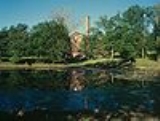
Watkins Mill
Encyclopedia
Watkins Mill, in Lawson, Missouri
, is a preserved woolen mill dating to the mid-19th century. Designated a National Historic Landmark
on November 13, 1966, the mill is protected as Missouri's Watkins Mill State Historic Site which preserve its machinery and business records as well as the building itself. The historic site itself is the centerpiece of 1500 acres (607 ha) Watkins Woolen Mill State Park.
The site also includes the Watkins house, dating to 1850. The twelve-room 2-1/2 story house includes three staircases, the main stair detailed in carved walnut. It remained a Watkins family home until 1945.
The Franklin School, or Octagonal School was built in 1856 and was used by the Watkins family and their employees until the mid-1870s, when it became a residence for mill workers. The unusual octagonal building was built of locally manufactured brick on Watkins land.
The Watkins' also donated the land for Mt. Vernon Baptist Church, built in 1871 to replace a log church dating to the 1850s. Of the $5000 construction cost, more than half was donated by Watkins.
The property became part of the Missouri state parks system in 1964, and it was designated a National Historic Landmark
in 1966.
, catfish
, crappie
and sunfish
and has a large sand swimming beach. A 3.8 miles (6.1 km) asphalt bicycling and walking trail follows the shoreline of the lake, and there is a separate 3.5 miles (5.6 km) equestrian
trail.
Lawson, Missouri
Lawson is a city in Clay and Ray counties in the U.S. state of Missouri. The population was 2,473 at the 2010 census.-Geography:Lawson is located at ....
, is a preserved woolen mill dating to the mid-19th century. Designated a National Historic Landmark
National Historic Landmark
A National Historic Landmark is a building, site, structure, object, or district, that is officially recognized by the United States government for its historical significance...
on November 13, 1966, the mill is protected as Missouri's Watkins Mill State Historic Site which preserve its machinery and business records as well as the building itself. The historic site itself is the centerpiece of 1500 acres (607 ha) Watkins Woolen Mill State Park.
Mill history
Watkins Mill was built in 1859-1860 by Waltus Watkins, who called it Bethany Plantation. Watkins built housing for the mill workers nearby, creating one of the first planned communities in North America. The community was effectively self-sufficient, the mill producing yarn and wool cloth. The mill operated at capacity until 1886, two years after Watkins' death. From 1886 to the turn of the twentieth century production declined. Nearly all of the mill machinery has been preserved, including a 50 horsepower steam boiler that powered the factory.The site also includes the Watkins house, dating to 1850. The twelve-room 2-1/2 story house includes three staircases, the main stair detailed in carved walnut. It remained a Watkins family home until 1945.
The Franklin School, or Octagonal School was built in 1856 and was used by the Watkins family and their employees until the mid-1870s, when it became a residence for mill workers. The unusual octagonal building was built of locally manufactured brick on Watkins land.
The Watkins' also donated the land for Mt. Vernon Baptist Church, built in 1871 to replace a log church dating to the 1850s. Of the $5000 construction cost, more than half was donated by Watkins.
The property became part of the Missouri state parks system in 1964, and it was designated a National Historic Landmark
National Historic Landmark
A National Historic Landmark is a building, site, structure, object, or district, that is officially recognized by the United States government for its historical significance...
in 1966.
State park
The recreation area of the state park has 96 campsites, most of which have electric hookups, and many of which are available year-round. A 100 acres (40.5 ha) lake supports fishing for bassBass (fish)
Bass is a name shared by many different species of popular gamefish. The term encompasses both freshwater and marine species. All belong to the large order Perciformes, or perch-like fishes, and in fact the word bass comes from Middle English bars, meaning "perch."-Types of basses:*The temperate...
, catfish
Catfish
Catfishes are a diverse group of ray-finned fish. Named for their prominent barbels, which resemble a cat's whiskers, catfish range in size and behavior from the heaviest and longest, the Mekong giant catfish from Southeast Asia and the second longest, the wels catfish of Eurasia, to detritivores...
, crappie
Crappie
Crappie is a genus of freshwater fish in the sunfish family of order Perciformes. The type species is P. annularis, the white crappie...
and sunfish
Lepomis
Lepomis is a genus of freshwater fish in the sunfish family of order Perciformes. The most recognizable species of the sixteen in this genus is the Bluegill....
and has a large sand swimming beach. A 3.8 miles (6.1 km) asphalt bicycling and walking trail follows the shoreline of the lake, and there is a separate 3.5 miles (5.6 km) equestrian
Equestrianism
Equestrianism more often known as riding, horseback riding or horse riding refers to the skill of riding, driving, or vaulting with horses...
trail.
External links
- Photographs of Watkins Mill, house and schoolhouse at the National Park Service's NRHP database
- Watkins Woolen Mill State Park and State Historic Site - official site
- Friends of Watkins Woolen Mill - details of the museum and activities

